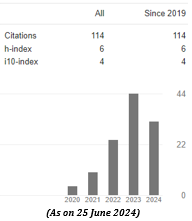DEVELOPMENT OF DESIGN AND MANUFACTURING OF A FIXED WING RADIO CONTROLLED MICRO AIR VEHICLE (MAV)
Abstract
Micro Air Vehicles (MAVs) are a new type of aircraft maturing day by day and have reached unprecedented levels of growth
recently. Similarly to larger Unmanned Air Vehicles (UAVs), MAVs have enormous potential in applications, both military and
civilian, like reconnaissance over battlefields and surveillance of urban areas, data relay, air sampling etc. This article describes
the development and selection of a fixed wing MAV with the analysis of simulated results. High wing theory with NACA 4412
aerofoil’s analytical data has been used to practically predict the performance of the MAV.
Downloads
References
[2] W. Shyy, D. A. Jenkins and R. W. Smith, “Study of Adaptive Shape Airfoils at Low Reynolds Number in Oscillatory Flows”, AIAA Journal, vol. 35, pp.1545-48, 1997.
[3] Marek, P., Smrcek, L.; "Development of DART MAV - Fixed Wing Hover-Capable Micro Air Vehicle", Advanced Engineering Design Conference, Prague, Czech Republic, June 2006.
[4] Watkins, S., et al., “Atmospheric Winds and Their Implications for Micro air Vehicles”, AIAA Journal, Vol.44, No.11, November2006.
[5] M. J. Khan, M. T. Iqbal and S. Mahboob, “A wind map of Bangladesh”, September 2008.
[6] Bohorquez, F. et al. “Design, Analysis and Performance of a Rotary Wing MAV”, Smart Structures Laboratory, Alfred Gessow Rotorcraft Center, Department of Aerospace Engineering, University of Maryland.
[7] Lennon, A., “Basics of R/C Model Aircraft Design”, Air Age Inc., Ridgefield, CT, USA, 199
Though MIJST follows the open access policy, the journal holds the copyright of each published items.

This work is licensed under a Creative Commons Attribution-NonCommercial 4.0 International License.
















